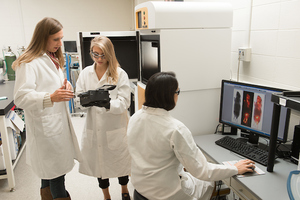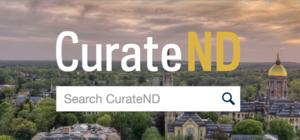 Sarah Chapman works with undergraduate researchers in the Notre Dame Integrated Imaging Facility.
Sarah Chapman works with undergraduate researchers in the Notre Dame Integrated Imaging Facility.The University of Notre Dame’s Integrated Imaging Facility didn’t always have a good way to track how researchers had applied data acquired from their facility’s equipment. But that changed when Hesburgh Libraries launched CurateND – a free, multifaceted research repository designed to showcase and preserve research outputs, such as data, papers, and presentations. The platform allows users to not only upload information, but to also tag their affiliated departments, centers, institutes, and facilities.
“By using CurateND, we were able to track more than just what our resource users were publishing, but how our facility users were applying the data they had gathered with the imaging equipment,” said Sarah Chapman, assistant director of the Integrated Imaging Facility.
Tracking equipment usage and the subsequent data acquisition is vital for core facilities across campus. By understanding how analyses and data collected by students, staff, and faculty are later used in research publications, facilities are able to better quantify the impact of their facility on research at Notre Dame, which in turn helps identify the equipment needing to be upgraded or replaced.
“We can track how many people use our instruments or how many hours are spent on each machine, but you can’t really put a price tag on the value of a research publication,” said Chapman. “CurateND helps the Integrated Imaging Facility showcase our capabilities, quality, and range for how we support research at Notre Dame.”

CurateND first launched in 2015 as a service for the Notre Dame community to preserve and provide access to research and data. The vision was to give students, faculty, and staff a location to deposit everything from official publications, such as books and patents, to other research outputs, such as lecture notes and raw data sets. The platform also stores every electronic dissertation submitted to the Graduate School since 2004.
Overall, the institutional repository accepts content in almost any format in order to serve the diverse research needs of the campus community. CurateND supports a wide variety of disciplines and collections ranging from mathematical software, like Bertini, to political science datasets, such as the Varieties of Democracy, to the Institute for Latino Studies oral history project.
“CurateND has a variety of unique content created by or in conjunction with Notre Dame researchers that is preserved as a part of institutional history and, in many cases, is now openly available to the world,” said Mikala Narlock, product owner of CurateND and assistant librarian at Hesburgh Libraries.
For faculty and researchers considering how to best manage their digital assets, the Navari Family Center for Digital Scholarship can help develop a data management plan as well as identify a preservation platform – like CurateND – that fits their specific research and scholarship needs. Since CurateND complies with funder requirements for grants, researchers can use the platform to store their data, assign it a Digital Object Identifier (DOI) number, and then cite the data set in their publications.
“The CurateND platform fits a niche for the preservation of distinctly Notre Dame scholarship and resources,” said Donald Brower, digital library infrastructure lead at Hesburgh Libraries and product owner of CurateND. “We are continuously working to enhance user experience of the service by refining the functionality and incorporating new features. I encourage the Notre Dame community to submit their ideas and feedback so we can make the platform as beneficial as possible to meet campus needs.”
By using the CurateND platform, the Notre Dame community can help elevate fellow research partners and contributors at the college-, department-, center-, and institute-level by tagging affiliations on their submissions. By doing so, core facilities and other resources like the Integrated Imaging Facility can also showcase the impact of their work.
To learn more about Notre Dame’s institutional repository, please visit curate.nd.edu or contact the product owners, Donald Brower and Mikala Narlock, at curate@nd.edu.
Originally published by at research.nd.edu on March 25, 2020.
